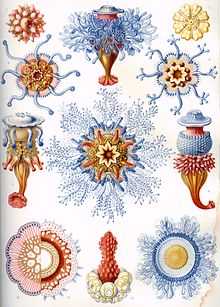Leptolinae
| Leptolinae | |
|---|---|
 | |
| Siphonophorae from Ernst Haeckel's 1904 Kunstformen der Natur | |
| Scientific classification | |
| Kingdom: | Animalia |
| Phylum: | Cnidaria |
| Class: | Hydrozoa |
| Subclass: | Leptolinae Haeckel, 1879 |
| Orders | |
| Synonyms | |
| |
Leptolinae (or Leptolina) are a subclass of the Hydrozoa Class (biology) in the cnidarian phylum. They contain the bulk of the paraphyletic "Hydroida" which were one of the main groupings of the Hydrozoa in older classifications and were placed at order rank. They also include, however, the highly advanced colonial jellies of the Siphonophora, which were not included in the "Hydroida".[1]
Systematics[1]
Some sources (e,g, ITIS use the younger alternate names Hydroidolina or Hydroidomedusa for Leptolina(e).
SUBCLASS LEPTOLINAE
- Order Anthomedusae - includes Laingoimedusae but monophyly requires verification
- Suborder Capitata
- Suborder Filifera
- Order Leptomedusae
- Suborder Conica
- Suborder Proboscidoidea
- Order Siphonophorae
- Suborder Calycophorae
- Suborder Cystonectae
- Suborder Physonectae
Other classifications
Other hydrozoan classifications, which are beset by paraphyly however, are also often seen. They do not unite the Leptolinae in a monophyletic taxon and thus do not have any merit according to modern understanding of hydrozoan phylogeny.
The traditional 19th-century system had the Leptominae dispersed among the following taxa:
- Order Anthoathecatae
- Order Laingiomedusae
- Order Siphonophora
- Suborders Anthomedusae and Leptomedusae of order Hydroida
A very old classification that is sometimes still seen had them in:
- Order Hydroida
- Order Siphonophorida
- Order Stylasterina
The system used by Animal Diversity Web uses:
- Order Capitata
- Order Filifera
- Order Hydroida
- Order Siphonophora
Catalogue of Life uses:
- Order Anthoathecata
- Order Hydroida
- Order Laingiomedusae
- Order Leptothecata
- Order Siphonophora
References
- ↑ 1.0 1.1 Peter Schuchert (2005). "Hydrozoan Phylogeny and Classification". The Hydrozoa Directory. Retrieved July 8, 2008.